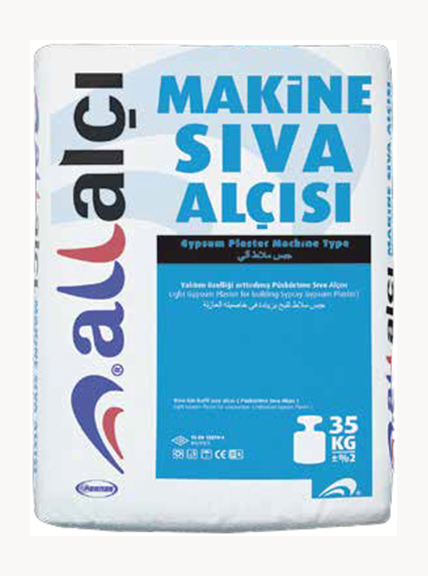Sprayed plaster with increased insulation properties…
Application area
On Concrete, Aerated Concrete, Pumice Block, Brick Surfaces…
Product description
Sprayed Plaster is a gypsum-based machine-applied interior surface plaster with increased heat and insulation properties.
Content Information
Calcium Sulfate Hemihydrate+Calcium Carbonate+Lime+Expanded Perlite+Tartaric Acid+Cellulosic Ether+Sodium Alkyl Sulfate
Physical and Chemical Properties
Form: Powder
Smell: No smell
Color: White, yellowish
Water Solubility: Soluble in water
Relevant Standards/Declarations
TS EN 13279-1: Building and Plaster Plasters - Light plaster plaster for building (Sprayed Plaster) B4/50/2 CE Declaration
Scope of application
Concrete Exposed concrete Pumice block It is applied on brick surfaces.
Packaging
Polypropylene laminated bag, 35 ±%2
Storage conditions
It should be kept closed in its original packaging, in a dry place and on a pallet.
Advantages
Due to its chemical structure, it does not create bacteria, mold and fungi. It has fire retardant properties due to the water in its structure. It balances the humidity of the environment and allows the material to breathe. More surfaces can be plastered with the machine, it is economical and saves time and labor. After application, a shiny surface is obtained and direct paint application can be made.
Application Surface Features
Application ambient temperature should be minimum + 5 ºC. Substances (dust, oil, etc.) that prevent adhesion on the application surface are cleaned. Before application, dry, hot and highly absorbent surfaces should be wetted with water. Plaster mesh should be used to prevent cracking at the junctions of different materials. The smoothness of the surface to be plastered should be checked. The surface of smooth-surfaced ceilings should be roughened before plaster application or primed with a material that ensures the mortar adheres to the surface.
Preparation of Mortar
ALL Spraying Plaster is placed in the machine chamber. The flow rate of water appropriate to the mixing ratios (water / plaster ratio: 10 kg of ALL Machine plaster is added to 5.5 liters of water) is adjusted. The mortar coming out of the plaster machine is taken into a 1 liter measuring cup and poured properly. If the spreading diameter of the mortar is 230-235 mm, the appropriate dosage is obtained. The mortar should be used within 150 minutes.
APPLICATION
Anos suitable for the thickness of the plaster are placed. The mortar is sprayed between the tiles. The surface is leveled and excess mortar is removed from the surface. Other anos are filled. Before the plaster mortar begins to pre-set, the surface is polished with a trowel. Approximately 30 minutes after the polishing process, water is sprinkled on the surface and the surface is trifiled. After 10 minutes, the surface is polished with a steel trowel and a shiny surface is obtained. Technical specifications may vary depending on site conditions and ground characteristics.
Technicial Specifications
| Physical appearance | White Powder |
| Contents | Calcium sulphate Hemihydrate Calcium Carbonate Lime Expanded Perlite Cellulosic Ether-Tartaric Acid Sodium Alpha Sulfanate |
| Water/Plaster Ratio | 5 liters of water 10kg of plaster |
| Setting Start Time (td) | min.50 max:120min. |
| Freezing Time (t3) | 210-250 min. |
| Volume Weight 6.1 Density (K.LA) | 800-900 g/lt |
| Spreading Diameter | 170-180mm |
| pH | 12-13 for 1 liter measuring cup |
| Flexural Tensile Strength | min.1.4 N/mm2 |
| Compressive Strength | min.31 N/mm2 |
| Adhesion Strength | min.0.3 |
| Response to Fire | A1 |
| Consumption Amount | 9.5-10.5 kg/m2 (10 mm thick) |
| Application Thickness | min 10mm max 15mm |
| Packaging 15.1 Type 15.2 Net Weight | Polypropylene Bag 35 kg 2 |


There are no reviews yet.